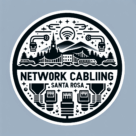What Are the Three Main Parts of a Cable? Understanding Cable Structure and Function
If you’ve ever wondered what’s inside a cable or how it carries electricity or data, you’re not alone. Whether you’re setting up network cables, power lines, or audio systems, understanding how a cable works helps you choose the right type for your needs — and avoid performance or safety issues.
So, what are the three main parts of a cable? Every cable, no matter its type or use, is built from three essential components: the conductor, the insulation, and the sheath. Each layer has a specific job to make sure the cable performs safely and efficiently. Our team of structured cabling professionals in Santa Rosa ensures every cable is installed with precision and reliability to support long-lasting network performance.
1. The Conductor – The Path for Electrical or Data Flow
At the core of every cable is the conductor, which carries electrical current or data signals from one point to another.
Common conductor materials include:
- Copper: The most widely used, known for excellent conductivity and flexibility.
- Aluminum: Lightweight and more affordable, used mainly in power transmission.
- Fiber optic strands: Instead of metal, fiber cables use glass or plastic strands to transmit light signals for high-speed data.
The conductor’s size, material, and strand count determine how much current it can carry and how efficiently it transmits signals. For example, in networking, twisted-pair copper conductors (like those in CAT6 cables) reduce interference, while fiber optic conductors provide faster data transmission.
2. The Insulation – Keeping the Flow Safe and Controlled
Surrounding the conductor is the insulation layer, which prevents the electrical current or data signal from escaping the conductor or contacting other wires.
Key purposes of insulation:
- Protects users and equipment from electric shocks.
- Prevents short circuits between conductors.
- Helps maintain signal quality and reduces interference.
Common insulation materials include:
- PVC (Polyvinyl Chloride): Affordable and durable, used in most power and communication cables.
- PE (Polyethylene): Great for low signal loss, ideal for data cables.
- Teflon (PTFE): Used in high-temperature or specialized applications.
Insulation thickness and quality are crucial — poor insulation can cause overheating, data loss, or even fire hazards.
3. The Sheath – The Protective Outer Layer
The sheath, sometimes called the jacket, is the outermost layer of a cable. It acts as a protective barrier that shields the inner components from physical damage, moisture, chemicals, and environmental wear.
Functions of the cable sheath:
- Protects from abrasion and impact.
- Provides resistance against UV light, oil, or water (depending on cable type).
- Adds structure and strength for easier handling and installation.
Common sheath materials include:
- PVC: Flexible and cost-effective, suitable for indoor use.
- LSZH (Low Smoke Zero Halogen): Reduces toxic emissions in case of fire — required in many California commercial buildings.
- PE (Polyethylene): Common in outdoor and underground cabling due to water resistance.
In harsh environments like construction sites or outdoor installations, the right sheath material ensures the cable remains durable and compliant with safety codes.
Visualizing Cable Construction
Think of a cable as a three-layered system:
- Conductor: Carries the signal or power.
- Insulation: Keeps it contained and controlled.
- Sheath: Shields and protects everything inside.
This simple structure applies to most cables — from your phone charger to industrial power lines and network data cables.
Why Understanding Cable Structure Matters
Knowing what’s inside a cable helps you choose the right one for your specific needs. For example:
- CAT6 Ethernet cables use twisted copper conductors with precision insulation and a protective jacket for fast, interference-free data transfer.
- Power cables need thicker insulation and tougher sheaths to handle higher voltages.
- Fiber optic cables replace metallic conductors with glass fibers and protective layers designed for light transmission.
Choosing the wrong cable type or structure can result in poor performance, safety hazards, or premature failure — especially in demanding environments.
Common Mistakes When Choosing Cables
Many installation problems stem from not understanding cable construction. Avoid these mistakes:
- Using indoor cables for outdoor applications (risk of moisture damage).
- Choosing cables without fire-rated or LSZH jackets in commercial buildings.
- Ignoring conductor size and insulation requirements for power loads.
Always check local building codes and manufacturer specifications, especially in California, where low-voltage and electrical standards are closely regulated.
Conclusion: A Simple Structure with a Big Impact
So, what are the three main parts of a cable? It all comes down to the conductor, insulation, and sheath — three layers that work together to deliver safe, efficient, and reliable performance. Different types of network connections rely on cables in unique ways—for instance, DSL technology uses telephone lines to deliver high-speed internet access.
From network installations to electrical wiring, understanding cable structure helps you make smarter choices, prevent issues, and ensure long-lasting performance.
If you’re setting up a new system or upgrading your network, always choose high-quality cables and work with licensed low-voltage professionals to get the best results.
